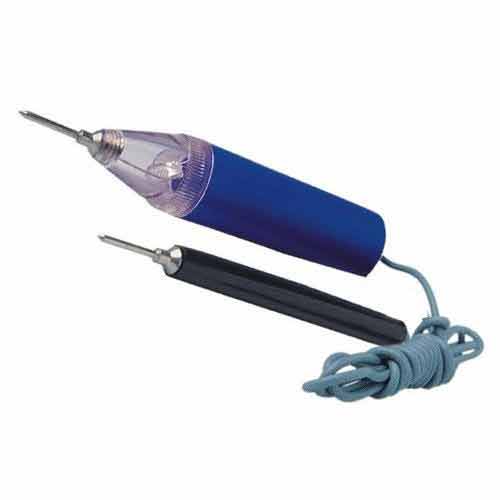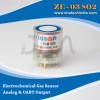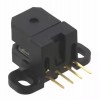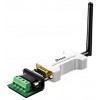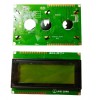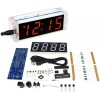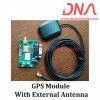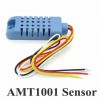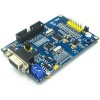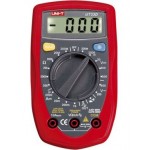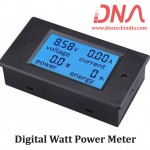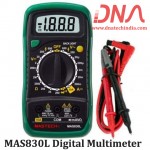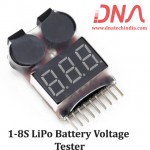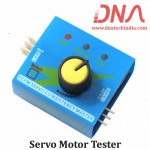Continuity Tester
- Stock: Out Of Stock NotInStock
- SKU: 3323 | DAE793
-
Rs.
103.84 (inc GST)
Rs.88.00 + GSTQty :
GST Invoice on all Purchase. So you will be eligible to take input tax credit. |
IF component not in Stock or require more quantity or want to buy in bulk e-mail us your requirements on: dnatechindia "at" gmail.com. |
| Shipping : Due to Covid-19 situation delivery will be affected. Delivery period due to covid-19 issue will be from 4 - 12 days depending upon your location. |
Continuity Tester
Continuity Tester
A continuity tester is an item of electrical test equipment used to determine if an electrical path can be established between two points; that is if an electrical circuit can be made. The circuit under test is completely de-energized prior to connecting the apparatus. The tester consists of an indicator in series with a source of electrical power - normally a battery, terminating in two test leads. If a complete circuit is established between the test-leads, the indicator is activated. The indicator may be an electric light or a buzzer. This led to the term "buzzing out a circuit" (which means to test for continuity) Audible continuity buzzers or beepers are built into some models of multimeter, and the continuity setting is normally shared with the ohmmeter setting. A popular design has the tester combined with a standard flashlight. A phone connector or jack plug in the rear of the unit permits a set of test leads to be plugged in effecting a quick conversion between the two applications. For situations where continuity testing must be done on high resistance circuits, or where delicate conductors and sensitive components that might be damaged by excessive current are present, a low voltage, low current device must be used. These typically use an op-amp and watch batteries to drive an LED as an indicator. These testers can be exquisitely sensitive; for example they will indicate if the test points are taken by both hands. There are times when a simple continuity test fails to reveal the problem. For example, vibration-induced problems in automobile wiring can be extremely difficult to detect because a short or open is not maintained long enough for a standard tester to respond. In these applications a latching continuity tester is used. A more complex device, it detects intermittent opens and shorts as well as steady-state conditions. These devices contain a fast acting electronic switch (generally a Schmitt trigger) forming a gated astable oscillator which detects and locks (latches) the indicator on an intermittent condition with a duration of less than a millisecond.
DNA solutions, Nashik has various types of Tools and Equipment's. Check out our complete collection of Tools and Equipment's.
If you are in Nashik you can buy this Electronic Component at our local shop at New CBS, Nashik or you can place order online and get it delivered at your doorstep anywhere in India. |
Features
- Selecting continuity testers also requires an analysis of options such as battery power, overload protection, and alarm types.
- Battery-powered devices are lightweight, portable, and suitable for in-field use.
- Continuity testers with overload protection have fuses to protect internal circuitry from voltage spikes.
Package Includes
1 x Continuity Tester
NEW Products
Product Page : New Products
Winsen ZE03-SO2 GAS Sensor Module
Winsen ZE03-SO2 GAS Sensor ModuleElectrochemical Detection Module ZE03-SO2ZE03-SO2 Gas sensor can be..
Rs.13,216.00 (inc GST)
Rs.11,200.00 + GST
SKU: 1764 | DAB100
Stock: 2
H9700 2 channel Digital Output Small Optical Encoder Module
H9700 2 channel Digital Output Small Optical Encoder ModuleH9700 Unipolar Hall-Effect Sensor ICThe H..
Rs.1,652.00 (inc GST)
Rs.1,400.00 + GST
SKU: 7439 | DAF661
Stock: 3
DTECH IOT5064A RS485 Serial to Ethernet Converter Bluetooth adapter
DTECH IOT5064A RS485 Serial to Ethernet Converter Bluetooth adapterDTECH IOT5064A RS485 Serial to Et..
Rs.6,486.76 (inc GST)
Rs.5,497.25 + GST
SKU: 7466 | DAG852
Stock: 1
JHD 204 20X4 GREEN LCD DISPLAY CHINESSE
JHD 204 20X4 GREEN LCD DISPLAY CHINESSEJHD 204 20X4 GREEN LCD DISPLAY CHINESSEThis is a 20x4 LCD dis..
Rs.402.09 (inc GST)
Rs.340.75 + GST
SKU: 7663 | DAF077
Stock: 5
Have You Seen
Product Page : Have You Seen
4 Digit DIY Electronic Clock kit Multicolor LED time Week Temperature Date Display with Clear case Cover (blue)
4 Digit DIY Electronic Clock kit Multicolor LED time Week Temperature Date Display with Clear case C..
Rs.796.50 (inc GST)
Rs.675.00 + GST
SKU: 7443 | DAF836
Stock: 5
GPS Module With External Antenna
GPS Module With External AntennaThis is a GPS Module with External Antenna. It is based on Skytra S1..
Rs.1,180.00 (inc GST)
Rs.1,000.00 + GST
SKU: 0397 | DAE263
Stock: 0
AMT1001 Resistive Temperature And Humidity Sensor
AMT1001 Resistive Temperature And Humidity SensorAMT1001 Resistive Humidity and Temperature Sensor M..
Rs.335.12 (inc GST)
Rs.284.00 + GST
SKU: 3291 | DAD402
Stock: 9
ADS1256 24bit High Precision ADC STM32F103C8T6 Module
ADS1256 24bit High Precision ADC STM32F103C8T6 ModuleADS1256 24bit High Precision ADC STM32F103C8T6 ..
Rs.5,198.70 (inc GST)
Rs.4,405.67 + GST
SKU: 7630 | DAF121
Stock: 0
Related Products
Multimeter UNI-T UT33D
Multimeter UNI-T UT33DIf you are a fresher in electronics & looking for low cost multimeter then..
Rs.767.00 (inc GST)
Rs.650.00 + GST
SKU: 0442 | DAB845
Stock: 0
Digital Watt Power Meter
Digital Watt Power Meter This is a compact four in one Digital Power meter. It displays Voltage..
Rs.1,650.82 (inc GST)
Rs.1,399.00 + GST
SKU: 1152 | DAA835
Stock: 0
MAS830L Digital Multimeter
Digital Multimeter MAS830LDigital multi-meters are widely used for measuring voltage, current, resis..
Rs.755.20 (inc GST)
Rs.640.00 + GST
SKU: 1320 | DAB846
Stock: 3
1-8S LiPo Battery Voltage Tester
1-8S LiPo Battery Voltage Tester1-8S LiPo Battery Voltage Tester with Low Volt Alarm Buzzer LEDThis ..
Rs.153.40 (inc GST)
Rs.130.00 + GST
SKU: 1516 | DAB041
Stock: 10
Digital Multi Servo Motor Tester
3 Channel Digital Servo Motor TesterDigital Multi Servo Tester ESC CCPM Consistency Master Speed Con..
Rs.117.46 (inc GST)
Rs.99.54 + GST

